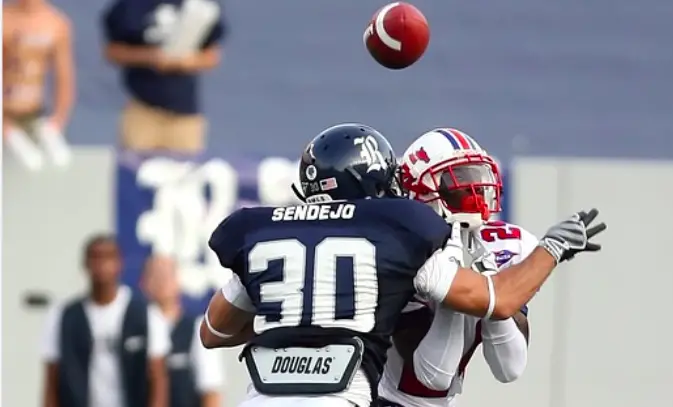A safety in football is a defensive player that is responsible for stopping deep passes from being completed. There are two safeties on the field in most defensive formations.
These two safeties will cover the deep portion of the field while also assisting in tackling the running back if he receives a handoff.
The two safety positions are referred to as the free safety and the strong safety.
Responsibilities
Deep Passes
The number responsibility of playing the safety position is protecting against deep passes. Either one or both safeties will be tasked with watching a deep portion of the field on most plays.
Safeties are typically the players which line up the furthest away from the line of scrimmage. This allows them to get a great view of the play as well as offers them a large cushion against the opposing receiver.
Run Game
Though breaking up passes is their forte safeties also have responsibilities in the run game. Once a safety knows the offense is running the ball and not passing he can abandon his deep coverage to stop the run.
In these instances, the safeties will often be the last line of defense against a rushing player. As in most cases if the running back is squared up with the safety it means he has gotten to the second level.
Quarterback Of The Secondary
Another common responsibility of the safety position is to act like a quarterback/leader of the secondary. What we mean by this is safeties are often ones who are giving out orders to the other defensive backs.
The safety position gives you a unique view of the game as you are often not covering any players for the first few seconds of the play. This gives the position a better opportunity to see what is happening on the field.
This can often lead to the safeties communicating with other defensive backs regarding strategies and tips to stop the offense.
Safety Attributes
Ball Skills
One of the most important attributes a safety can have is good ball skills. It is common the safeties lead the NFL in interceptions. This means that this position is going to have chances to catch the ball.
Additionally, these ball skills will translate to breaking passes up or stripping defenders. Breaking up a deep pass or forcing a fumble are the sorts of plays that allow safeties a massive impact on the game.
Big Hits
Another big attribute within the safety position is big hits. Safeties are often known for their huge hits whether it’s downfield or at the line of scrimmage.
Since safeties play deeper in the be backfield they are often able to get a running start before making a hit. On a running play for example the safety will have had a chance to gain a large amount of speed before making contact with the running back.
Delivering these big hits as a safety can crucial. If it is done to receivers catching deep passes it is fairly likely the pass will end up incomplete. If a safety hits a running back hard as he enters the second level he may cause a fumble.
This is one of those safety traits that can result in huge benefits for your team.
Football IQ
Football IQ is another important factor when it comes to playing the safety position. As a safety reading plays before they happen is a must. Afterall this position is typically resposnible for covering more ground than any other position.
Elite safeties like Troy Palamaulu or Ed Reed seemed to know where the play was going before the ball was even snapped.
When it comes to defence the safety position requires a higher level of football IQ than any other.
Build
The build of a safety varies amongst players and defensive systems but these players typically sit between the cornerbacks and linebackers when it comes to size. Safeties are usually an average height usually somewhere in the 5″10 to – 6 Foot range.
Safeties are typically heavier than cornerbacks as their build requires them to be more active in the run defence.
Postioning
Since there are two safeties on the field the positioning of these players changes often. Though in most cases you will find that safeties line up deep down the field. Safeties are almost always the defensive player furthest from the line of scrimmage.
Often times the two safeties will split up the deep section of the field. In these situations, one safety will line up deep to the right and the other will line up deep to the left.
Concluding Thoughts
We hope this guide to understanding the safety position taught you everything you needed to know.
If you have any more questions regarding safeties or other positions check out the cornerback position breakdown or learn what a nickel corner does.

